A Dispatch Strategy for the Analysis of the Technical, Economic, and Environmental Performance of a Hybrid Renewable Energy System
Abstract
:1. Introduction
- Providing people in the region with access to continuous and uninterrupted electrical energy improves their quality of life.
- Rural communities’ access to uninterrupted energy reduces labor loss by expanding the use of electrical equipment in agriculture and animal husbandry. This supports economic activities.
- Uninterrupted electricity contributes to society’s social development. It increases welfare levels by facilitating communication and education services.
- Because they use local resources, HRESs contribute to the sustainable development of rural areas, which reduces the development gap between urban and rural areas.
- To increase energy security by designing an MG using RESs and to contribute to the sustainability of energy demands as a result of system optimization;
- To contribute to the prevention of environmental pollution by reducing greenhouse gas emissions;
- To reduce capital, operation/maintenance/repair, and conversion costs and to make a cost-effective energy production with the energy management strategy created in MATLAB environment;
- To ensure the uninterrupted energy security of the MG, which is created independently from the grid, by using the biogas potential of the community to both realize uninterrupted energy production and prevent environmental pollution by disposing of animal waste.
Literature
2. Materials and Methods
2.1. System Modeling
2.1.1. Load Profile
2.1.2. Meteorologic Data of the Region
2.1.3. Biomass Resources
2.2. Mathematical Modeling of System Components
2.2.1. System Limitations
2.2.2. Mathematical Model of PV System
2.2.3. Wind Turbine
2.2.4. Biogas Generator
2.3. Economic Modeling
2.4. Dispatch Strategy
3. Results and Discussion
3.1. Electrical Analysis
3.2. Economic Analysis
3.3. Environmental Analysis
3.4. Sensitivity Analysis
4. Conclusions
Author Contributions
Funding
Institutional Review Board Statement
Informed Consent Statement
Data Availability Statement
Conflicts of Interest
References
- Jain, A.K.; Barua, A.; Mishra, P.K. Optimal design and development of a microgrid for off-grid rural communities. Int. J. Inf. Technol. 2024, 16, 2229–2239. [Google Scholar] [CrossRef]
- Available online: https://www.iea.org/reports/world-energy-outlook-2023/overview-and-key-findings (accessed on 21 August 2024).
- Chiari, L.; Zecca, A. Constraints of fossil fuels depletion on global warming projections. Energy Policy 2011, 39, 5026–5034. [Google Scholar] [CrossRef]
- Levitan, O.; Dinamarca, J.; Hochman, G.; Falkowski, P.G. Diatoms: A fossil fuel of the future. Trends Biotechnol. 2014, 32, 117–124. [Google Scholar] [CrossRef]
- Halkos, G.E.; Gkampoura, E.-C. Reviewing usage, potentials, and limitations of renewable energy sources. Energies 2020, 13, 2906. [Google Scholar] [CrossRef]
- Zia, M.F.; Elbouchikhi, E.; Benbouzid, M. Microgrids energy management systems: A critical review on methods, so-lutions, and prospects. Appl. Energy 2018, 222, 1033–1055. [Google Scholar] [CrossRef]
- Parhizi, S.; Lotfi, H.; Khodaei, A.; Bahramirad, S. State of the art in research on microgrids: A review. IEEE Access 2015, 3, 890–925. [Google Scholar] [CrossRef]
- Tazvinga, H.; Dzobo, O. Feasibility Study of a Solar-Biogas System for Off-Grid Applications. In Proceedings of the 2019 9th International Conference on Power and Energy Systems (ICPES), Perth, WA, Australia, 10–12 December 2019; IEEE: Piscataway, NJ, USA, 2019; pp. 1–5. [Google Scholar]
- Ashraful Islam, M.; Naushad Ali, M.M.; Mollick, T.; Islam, A.; Benitez, I.B.; Sidi Habib, S.; Al Mansur, A.; Shahadat Hossain Lipu, M.; Flah, A.; Kanan, M. Assessing the feasibility and quality performance of a renewable Energy-Based hybrid microgrid for electrification of remote communities. Energy Convers. Manag. X 2024, 23, 100674. [Google Scholar] [CrossRef]
- Erdal, S.; Aydın, E.; Andiç, C. Design of a Stand-Alone Hybrid Solar/Wind/Batt ery/D iesel Microgrid for a Wastewater Treatment Plant in İzmir Using HOMER Pro Software. Turk. J. Electr. Power Energy Syst. 2024, 4, 26–39. [Google Scholar]
- Roy, P.; He, J.; Zhao, T.; Singh, Y.V. Recent advances of wind-solar hybrid renewable energy systems for power gener-ation: A review. IEEE Open J. Ind. Electron. Soc. 2022, 3, 81–104. [Google Scholar] [CrossRef]
- Rekioua, D.; Rekioua, D. Hybrid renewable energy systems overview. In Hybrid Renewable Energy Systems: Optimization and Power Management Control; Springer: Cham, Switzerland, 2020; pp. 1–37. [Google Scholar]
- Murty, V.V.; Kumar, A. Optimal energy management and techno-economic analysis in microgrid with hybrid renewable energy sources. J. Mod. Power Syst. Clean Energy 2020, 8, 929–940. [Google Scholar] [CrossRef]
- El-Maaroufi, A.; Daoudi, M.; Ahl Laamara, R. Techno-economic analysis of a PV/WT/biomass off-grid hybrid power system for rural electrification in northern Morocco using HOMER. Renew. Energy 2024, 231, 120904. [Google Scholar] [CrossRef]
- Nadeem, T.B.; Ahmed, A.; Saad, M.; Naqvi, A.A. Design and optimization of off-grid solar PV and biomass-based hybrid renewable energy system (HRES) for electrification of a rural community in Tharparkar, Pakistan. Environ. Dev. Sustain. 2024. [Google Scholar] [CrossRef]
- Khalil, H.; Abd El-Hamied, R. Comparative Analysis and Assessment of Economic Profitability of a Hybrid Renewable Energy Framework via HOMER Optimization in Jordan. Int. J. Heat Technol. 2024, 42, 933–948. [Google Scholar] [CrossRef]
- Santos, L.H.S.; Silva, J.A.A.; López, J.C.; Arias, N.B.; Rider, M.J.; Da Silva, L.C.P. Integrated optimal sizing and dispatch strategy for microgrids using HOMER Pro. In Proceedings of the 2021 IEEE PES Innovative Smart Grid Technologies Conference—Latin America (ISGT Latin America), Lima, Peru, 15–17 September 2021; IEEE: Piscataway, NJ, USA, 2021; pp. 1–5. [Google Scholar]
- Miah, M.S.; Swazal, M.A.M.; Mittro, S.; Islam, M.M. Design of a grid-tied solar plant using homer pro and an optimal home energy management system. In Proceedings of the 2020 IEEE International Conference for Innovation in Technology (INOCON), Bangluru, India, 6–8 November 2020; IEEE: Piscataway, NJ, USA, 2020; pp. 1–7. [Google Scholar]
- Toopshekan, A.; Yousefi, H.; Astaraei, F.R. Technical, economic, and performance analysis of a hybrid energy system using a novel dispatch strategy. Energy 2020, 213, 118850. [Google Scholar] [CrossRef]
- Yazhini, K.; Aarthi, N. Optimal Sizing of Rural Microgrid using HOMER Pro Software. In Proceedings of the 2022 IEEE 7th International Conference on Recent Advances and Innovations in Engineering (ICRAIE), Mangalore, India, 1–3 December 2022; IEEE: Piscataway, NJ, USA, 2022; pp. 455–460. [Google Scholar]
- Aziz, A.S.; Tajuddin, M.F.N.; Hussain, M.K.; Adzman, M.R.; Ghazali, N.H.; Ramli, M.A.M.; Khalil Zidane, T.E. A new optimization strategy for wind/diesel/battery hybrid energy system. Energy 2022, 239, 122458. [Google Scholar] [CrossRef]
- Ishraque, M.F.; Rahman, A.; Shezan, S.A.; Shafiullah, G. Operation and assessment of a microgrid for maldives: Islanded and grid-tied mode. Sustainability 2022, 14, 15504. [Google Scholar] [CrossRef]
- Melit, A.; Chekired, F.; Meflah, A. Optimal Sizing of a Hybrid Microgrid System in a Mediterranean Climate. In Proceedings of the 2023 14th International Renewable Energy Congress (IREC), Sousse, Tunisia, 16–18 December 2023; IEEE: Piscataway, NJ, USA, 2023; pp. 1–5. [Google Scholar]
- Chebabhi, A.; Tegani, I.; Benhamadouche, A.D.; Kraa, O. Optimal design and sizing of renewable energies in microgrids based on financial considerations a case study of Biskra, Algeria. Energy Convers. Manag. 2023, 291, 117270. [Google Scholar] [CrossRef]
- Merino, C.; Castro, R. Optimization of a Hybrid Solar–Wind Microgrid for Sustainable Development: A Case Study in Antofagasta, Chile. Sustainability 2024, 16, 3668. [Google Scholar] [CrossRef]
- Yadav, S.; Kumar, P.; Kumar, A. Techno-economic assessment of hybrid renewable energy system with multi energy storage system using HOMER. Energy 2024, 297, 131231. [Google Scholar] [CrossRef]
- Odekunle, O.; Asare, T.; Beem, H.R. Feasibility study of a PV/biogas/grid system for the Micro-grid supply at Ashesi University. In Proceedings of the IEEE Green Energy and Systems Conference (IGESC), Long Beach, CA, USA, 13–14 November 2023; IEEE: Piscataway, NJ, USA, 2023; pp. 1–6. [Google Scholar]
- Maleki, A.; Khajeh, M.G.; Rosen, M.A. Two heuristic approaches for the optimization of grid-connected hybrid solar–hydrogen systems to supply residential thermal and electrical loads. Sustain. Cities Soc. 2017, 34, 278–292. [Google Scholar] [CrossRef]
- Khan, M.U.; Hassan, M.; Nawaz, M.H.; Ali, M.; Wazir, R. Techno-economic Analysis of PV/wind/biomass/biogas hybrid system for remote area electrification of Southern Punjab (Multan), Pakistan using HOMER Pro. In Proceedings of the 2018 International Conference on Power Generation Systems and Renewable Energy Technologies (PGSRET), Islamabad, Pakistan, 10–12 September 2018; IEEE: Piscataway, NJ, USA, 2018; pp. 1–6. [Google Scholar]
- Hosseinalizadeh, R.; Shakouri, H.; Amalnick, M.S.; Taghipour, P. Economic sizing of a hybrid (PV–WT–FC) renewable energy system (HRES) for stand-alone usages by an optimization-simulation model: Case study of Iran. Renew. Sustain. Energy Rev. 2016, 54, 139–150. [Google Scholar] [CrossRef]
- Lata-García, J.; Jurado, F.; Fernández-Ramírez, L.M.; Sánchez-Sainz, H. Optimal hydrokinetic turbine location and techno-economic analysis of a hybrid system based on photovoltaic/hydrokinetic/hydrogen/battery. Energy 2018, 159, 611–620. [Google Scholar] [CrossRef]
- Luta, D.N.; Raji, A.K. Optimal sizing of hybrid fuel cell-supercapacitor storage system for off-grid renewable applications. Energy 2019, 166, 530–540. [Google Scholar] [CrossRef]
- Atik, I.; Sekin, A. Hibrit yenilenebilir enerji sistem tasarımı: Balıkesir örneği. Dicle Üniversitesi Mühendislik Fakültesi Mühendislik Derg. 2022, 13, 517–529. [Google Scholar] [CrossRef]
- Chowdhury, S.; Hossan, A.; Semel, S.A.; Zhou, M. Hydrogen Energy Storage Based Biogas Power Plant in Bangladesh: Design and Optimal Cost Analysis. In Proceedings of the 2022 10th International Conference on Smart Grid (icSmartGrid), Istanbul, Turkey, 27–29 June 2022; IEEE: Piscataway, NJ, USA, 2022; pp. 35–39. [Google Scholar]
- Yimen, N.; Monkam, L.; Tcheukam-Toko, D.; Musa, B.; Abang, R.; Fombe, L.F.; Abbasoglu, S.; Dagbasi, M. Optimal design and sensitivity analysis of distributed biomass-based hybrid renewable energy systems for rural electrification: Case study of different photovoltaic/wind/battery-integrated options in Babadam, northern Cameroon. IET Renew. Power Gener. 2022, 16, 2939–2956. [Google Scholar] [CrossRef]
- Das, B.K.; Al-Abdeli, Y.M. Optimisation of stand-alone hybrid CHP systems meeting electric and heating loads. Energy Convers. Manag. 2017, 153, 391–408. [Google Scholar] [CrossRef]
- Shah, K.K.; Mundada, A.S.; Pearce, J.M. Performance of US hybrid distributed energy systems: Solar photovoltaic, battery and combined heat and power. Energy Convers. Manag. 2015, 105, 71–80. [Google Scholar] [CrossRef]
- Li, C.; Zhou, D.; Wang, H.; Lu, Y.; Li, D. Techno-economic performance study of stand-alone wind/diesel/battery hybrid system with different battery technologies in the cold region of China. Energy 2020, 192, 116702. [Google Scholar] [CrossRef]
- Ma, T.; Javed, M.S. Integrated sizing of hybrid PV-wind-battery system for remote island considering the saturation of each renewable energy resource. Energy Convers. Manag. 2019, 182, 178–190. [Google Scholar] [CrossRef]
- Nouh, A.; Khatab, M.F. Partitioning Street Lights Load on Grid-Photovoltaic System as an Alternative Solution for Illuminating Al-Bayda City Roads. In Proceedings of the 2020 11th International Renewable Energy Congress (IREC), Hammamet, Tunisia, 29–31 October 2020; IEEE: Piscataway, NJ, USA, 2020; pp. 1–6. [Google Scholar]
- Qhadafhi, M.; Raharjo, J.; Adam, K.B. Implementation of Home Energy Management System for Indonesia Homes with Hybrid Power Plant. In Proceedings of the 2023 4th International Conference on High Voltage Engineering and Power Systems (ICHVEPS), Denpasar Bali, Indonesia, 6–10 August 2023; IEEE: Piscataway, NJ, USA, 2023; pp. 118–122. [Google Scholar]
- Alghamdi, A.H.S. Technical and Economic Analysis of Solar Energy Application for a Hospital Building in Dammam, Saudi Arabia. Master’s Thesis, Auckland University of Technology, Auckland, New Zealand, 2019. [Google Scholar]
- Ammari, C.; Belatrache, D.; Makhloufi, S.; Saifi, N. Techno-economic analysis of a stand-alone photovoltaic system with three different storage systems for feeding isolated houses in south Algeria. Energy Storage 2021, 3, e211. [Google Scholar] [CrossRef]
- Aziz, A.S.; Tajuddin, M.F.N.; Zidane, T.E.K.; Su, C.-L.; Alrubaie, A.J.K.; Alwazzan, M.J. Techno-economic and environ-mental evaluation of PV/diesel/battery hybrid energy system using improved dispatch strategy. Energy Rep. 2022, 8, 6794–6814. [Google Scholar] [CrossRef]
- Available online: https://homerenergy.com/pdf/HOMERHelpManual.pdf (accessed on 21 February 2024).
- Available online: https://sel.me.wisc.edu/trnsys/weather/tmy2data.htm (accessed on 22 August 2024).
- Bhatt, A.; Sharma, M.P.; Saini, R.P. Feasibility and sensitivity analysis of an off-grid micro hydro–photovoltaic–biomass and biogas–diesel–battery hybrid energy system for a remote area in Uttarakhand state, India. Renew. Sustain. Energy Rev. 2016, 61, 53–69. [Google Scholar] [CrossRef]
- Razmi, D.; Lu, T. A literature review of the control challenges of distributed energy resources based on microgrids (MGs): Past, present and future. Energies 2022, 15, 4676. [Google Scholar] [CrossRef]
- Khare, V.; Nema, S.; Baredar, P. Solar–wind hybrid renewable energy system: A review. Renew. Sustain. Energy Rev. 2016, 58, 23–33. [Google Scholar] [CrossRef]
- Peng, C.-Y.; Kuo, C.-C.; Tsai, C.-T. Optimal configuration with capacity analysis of PV-plus-BESS for behind-the-meter application. Appl. Sci. 2021, 11, 7851. [Google Scholar] [CrossRef]
- Liu, G.; Li, M.; Zhou, B.; Chen, Y.; Liao, S. General indicator for techno-economic assessment of renewable energy resources. Energy Convers. Manag. 2018, 156, 416–426. [Google Scholar] [CrossRef]
- Mudgal, V.; Reddy, K.; Mallick, T. Techno-economic analysis of standalone solar photovolta-ic-wind-biogas hybrid renewable energy system for community energy requirement. Future Cities Environ. 2019, 5, 11. [Google Scholar] [CrossRef]
- Ibrahim, M.M.; Mostafa, N.H.; Osman, A.H.; Hesham, A. Performance analysis of a stand-alone hybrid energy system for desalination unit in Egypt. Energy Convers. Manag. 2020, 215, 112941. [Google Scholar] [CrossRef]
- Alqahtani, N.; Balta-Ozkan, N. Assessment of rooftop solar power generation to meet residential loads in the city of neom, Saudi Arabia. Energies 2021, 14, 3805. [Google Scholar] [CrossRef]
- Irigoyen Tineo, A. Energy Management System Benchmarking for a Remote Microgrid; UC3M: Getafe, Spain, 2017. [Google Scholar]
- Available online: https://data.mendeley.com/datasets/f39n2kpk79/1 (accessed on 15 July 2024).
- Abdulgalil, M.A.; Khalid, M.; Alismail, F. Optimal sizing of battery energy storage for a grid-connected microgrid subjected to wind uncertainties. Energies 2019, 12, 2412. [Google Scholar] [CrossRef]
- Aziz, A.S.; Tajuddin, M.F.N.; Adzman, M.R.; Ramli, M.A.; Mekhilef, S. Energy management and optimization of a PV/diesel/battery hybrid energy system using a combined dispatch strategy. Sustainability 2019, 11, 683. [Google Scholar] [CrossRef]
- Ennemiri, N.; Berrada, A.; Emrani, A.; Abdelmajid, J.; El Mrabet, R. Optimization of an off-grid PV/biogas/battery hybrid energy system for electrification: A case study in a commercial platform in Morocco. Energy Convers. Manag. X 2024, 21, 100508. [Google Scholar] [CrossRef]
- Gökçek, M.; Kale, C. Techno-economical evaluation of a hydrogen refuelling station powered by Wind-PV hybrid power system: A case study for İzmir-Çeşme. Int. J. Hydrogen Energy 2018, 43, 10615–10625. [Google Scholar] [CrossRef]
- Available online: https://enerji.gov.tr/evced-cevre-ve-iklim-elektrik-uretim-tuketim-emisyon-faktorleri (accessed on 24 August 2024).

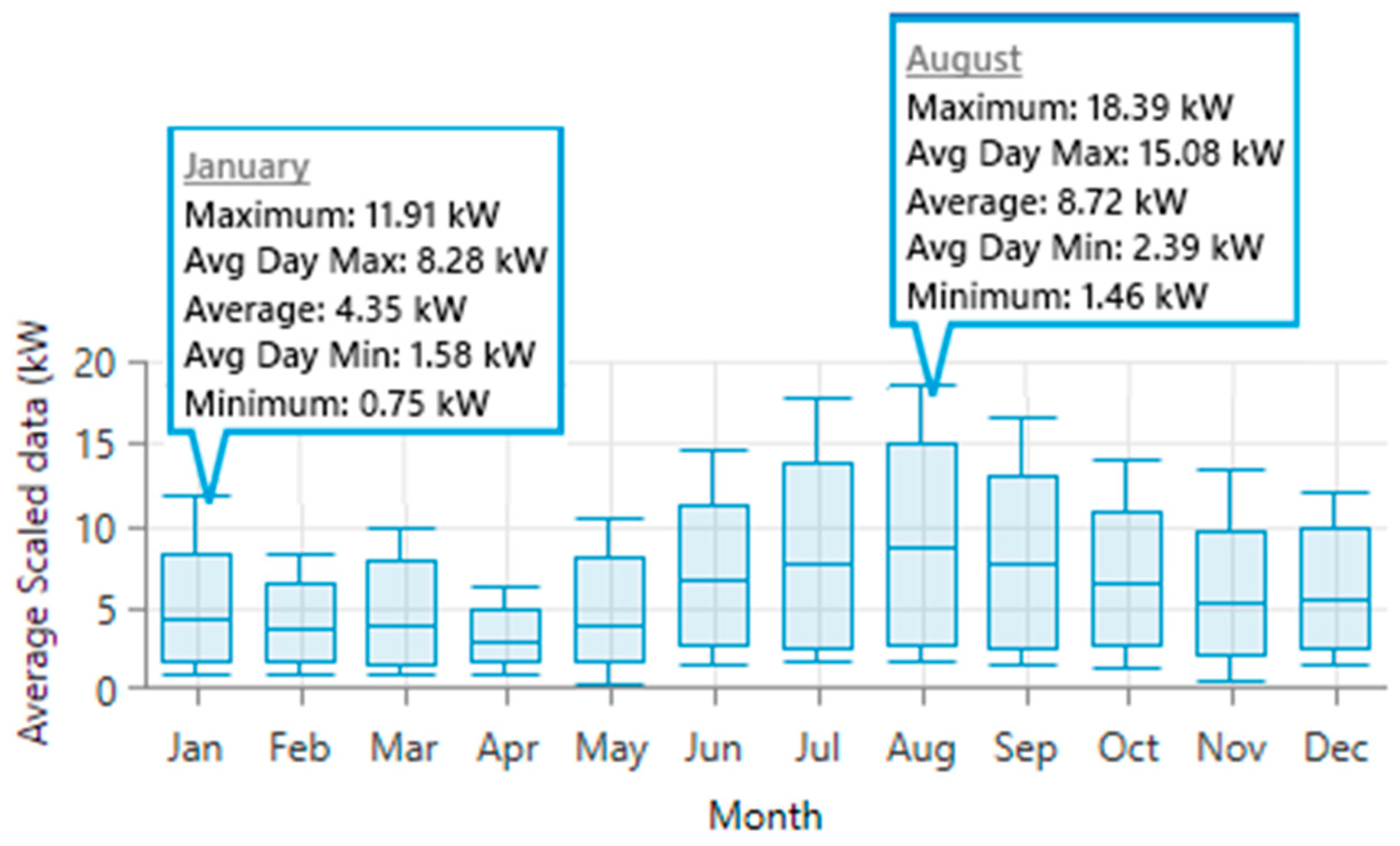
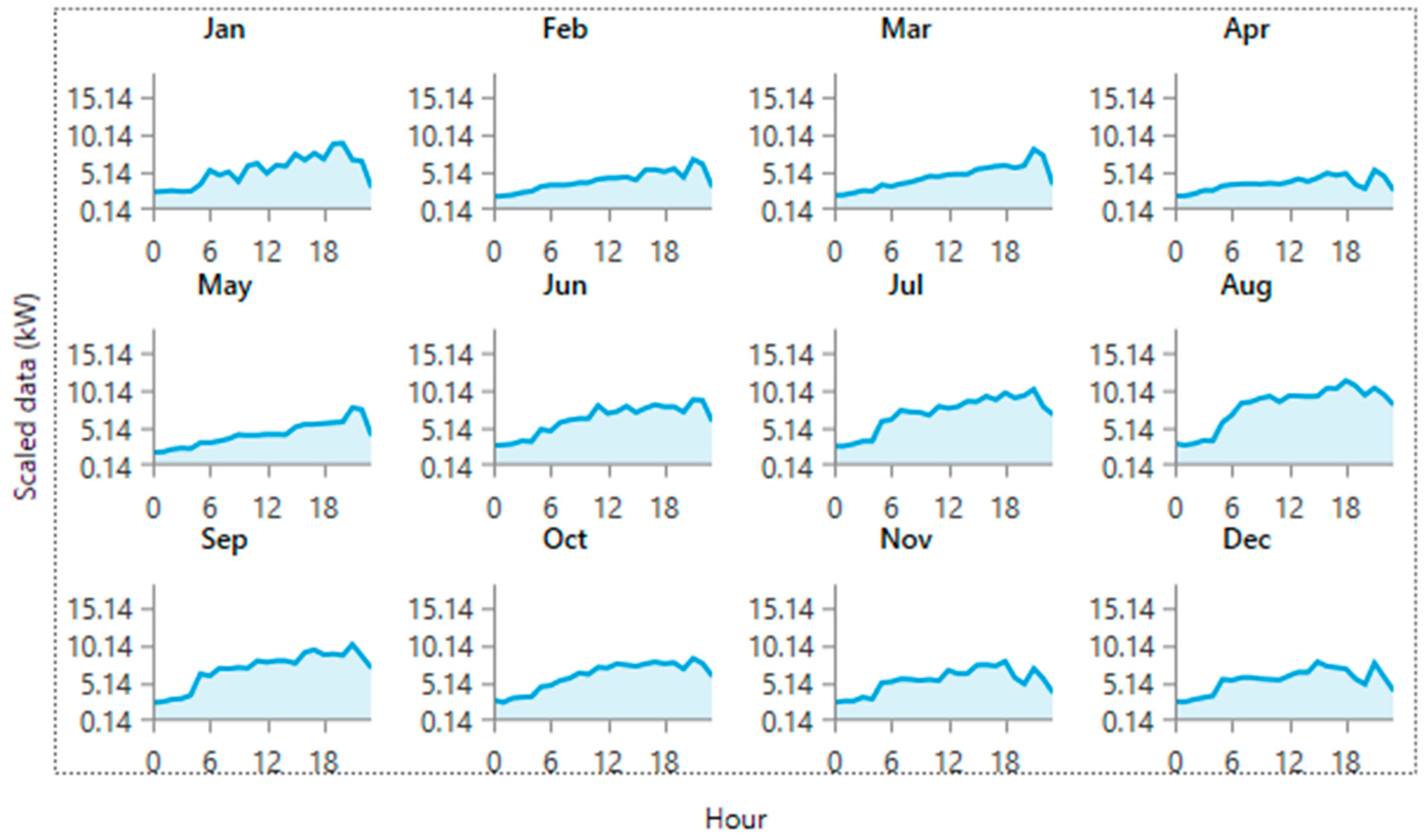


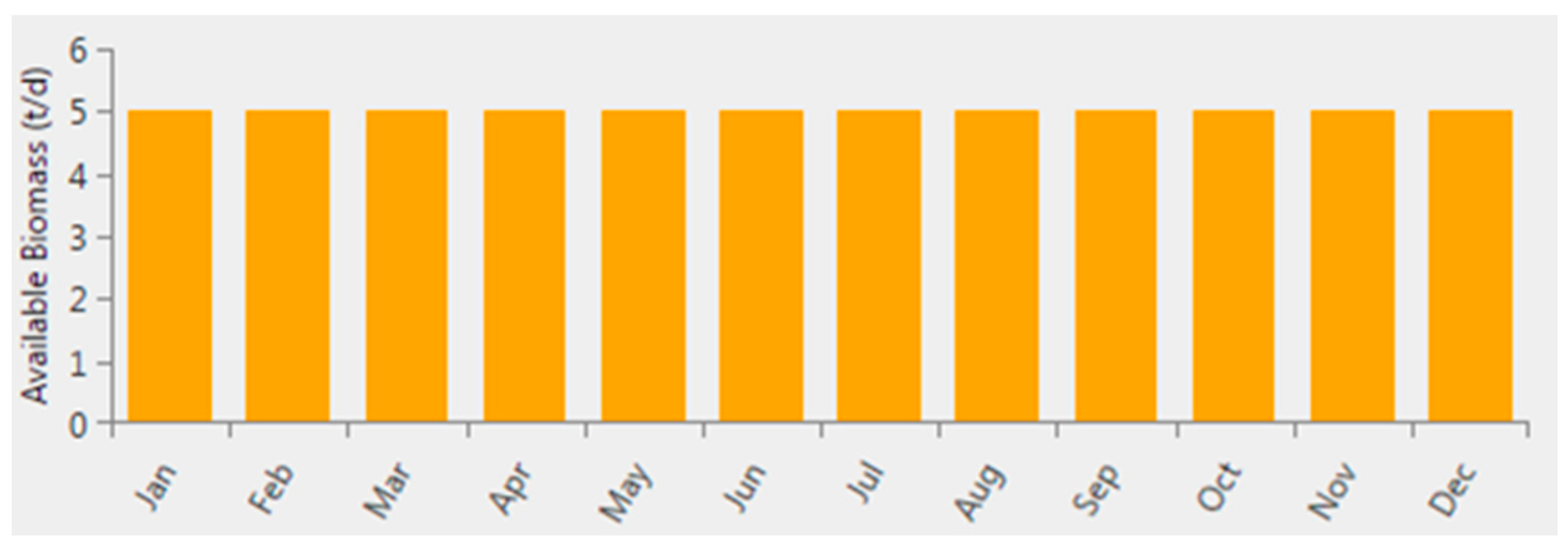



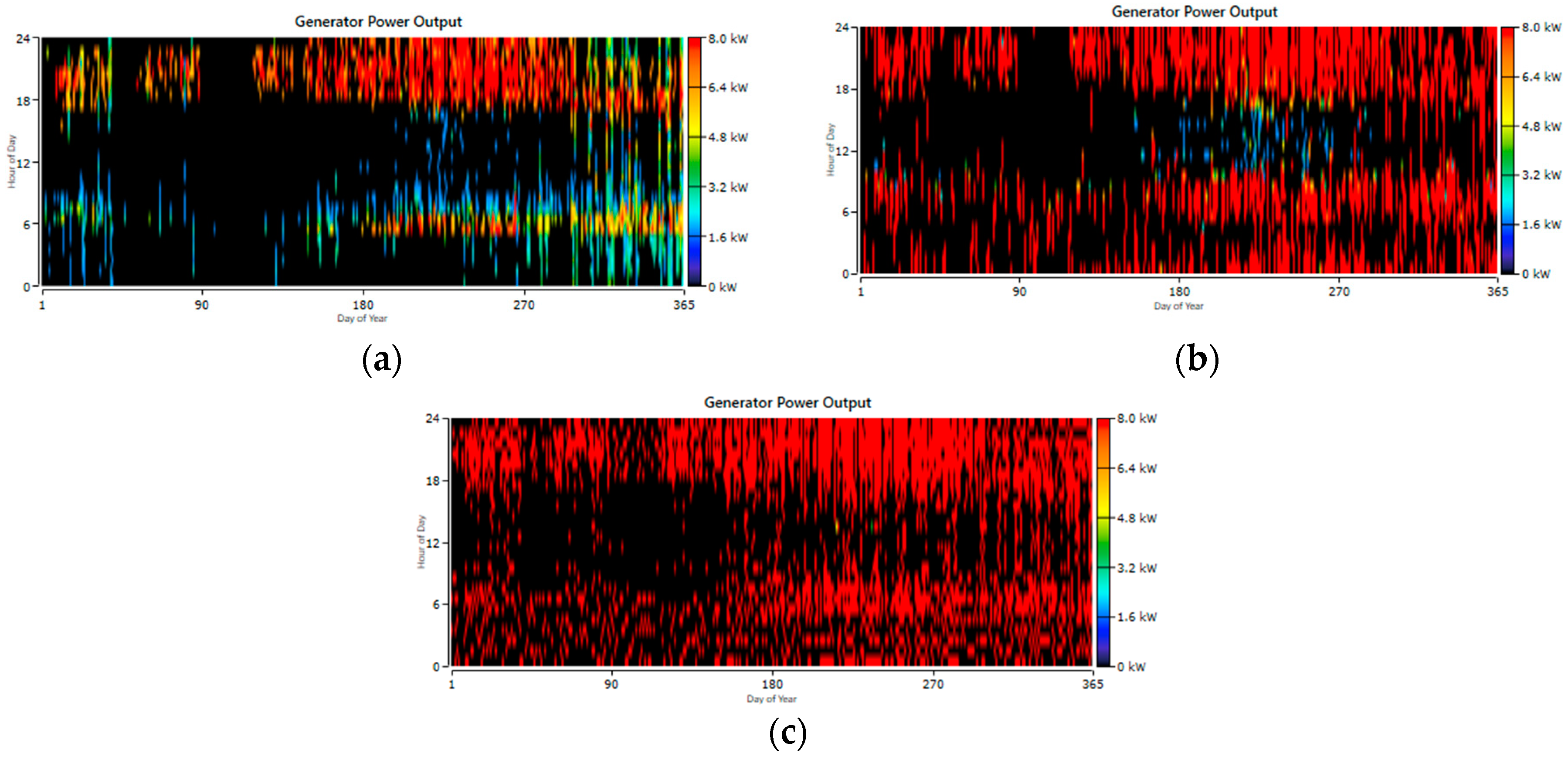
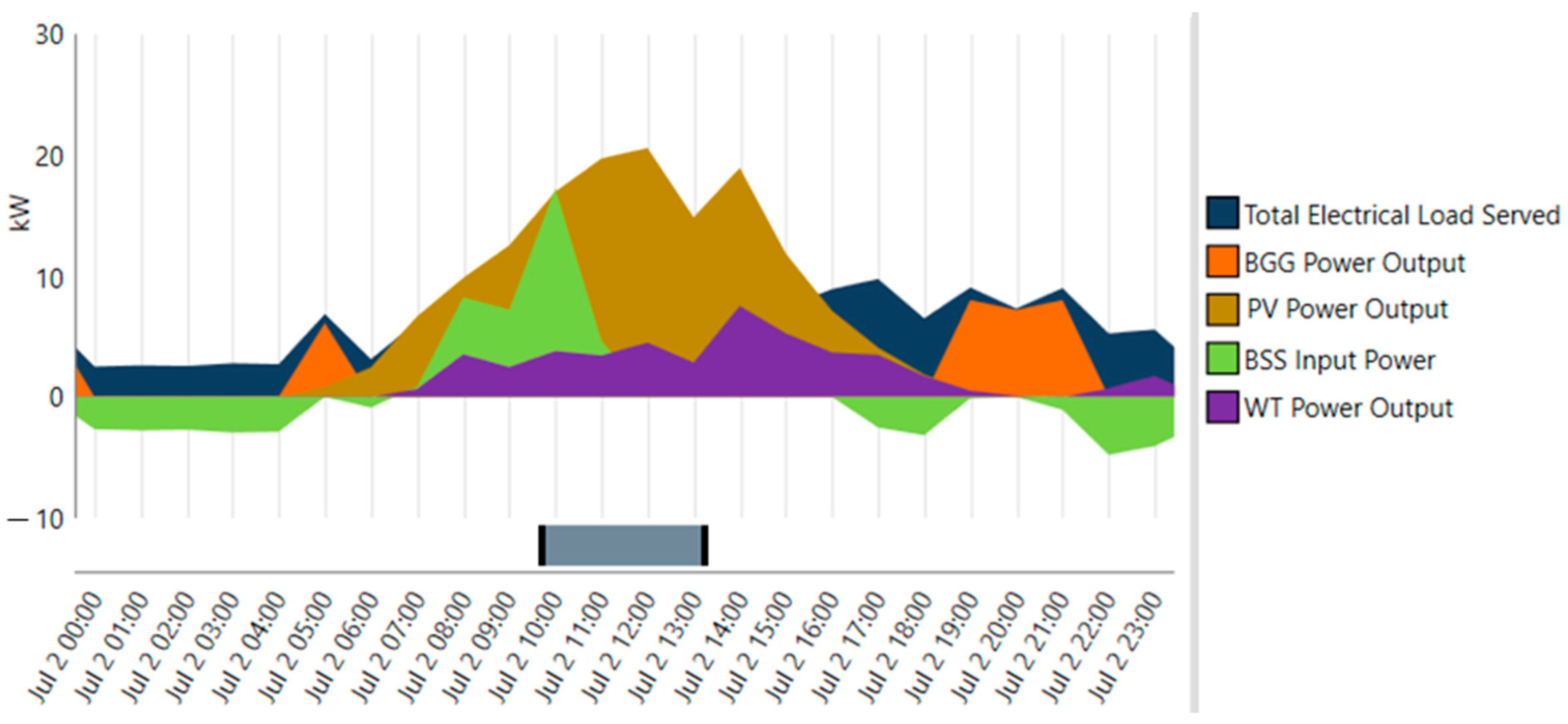

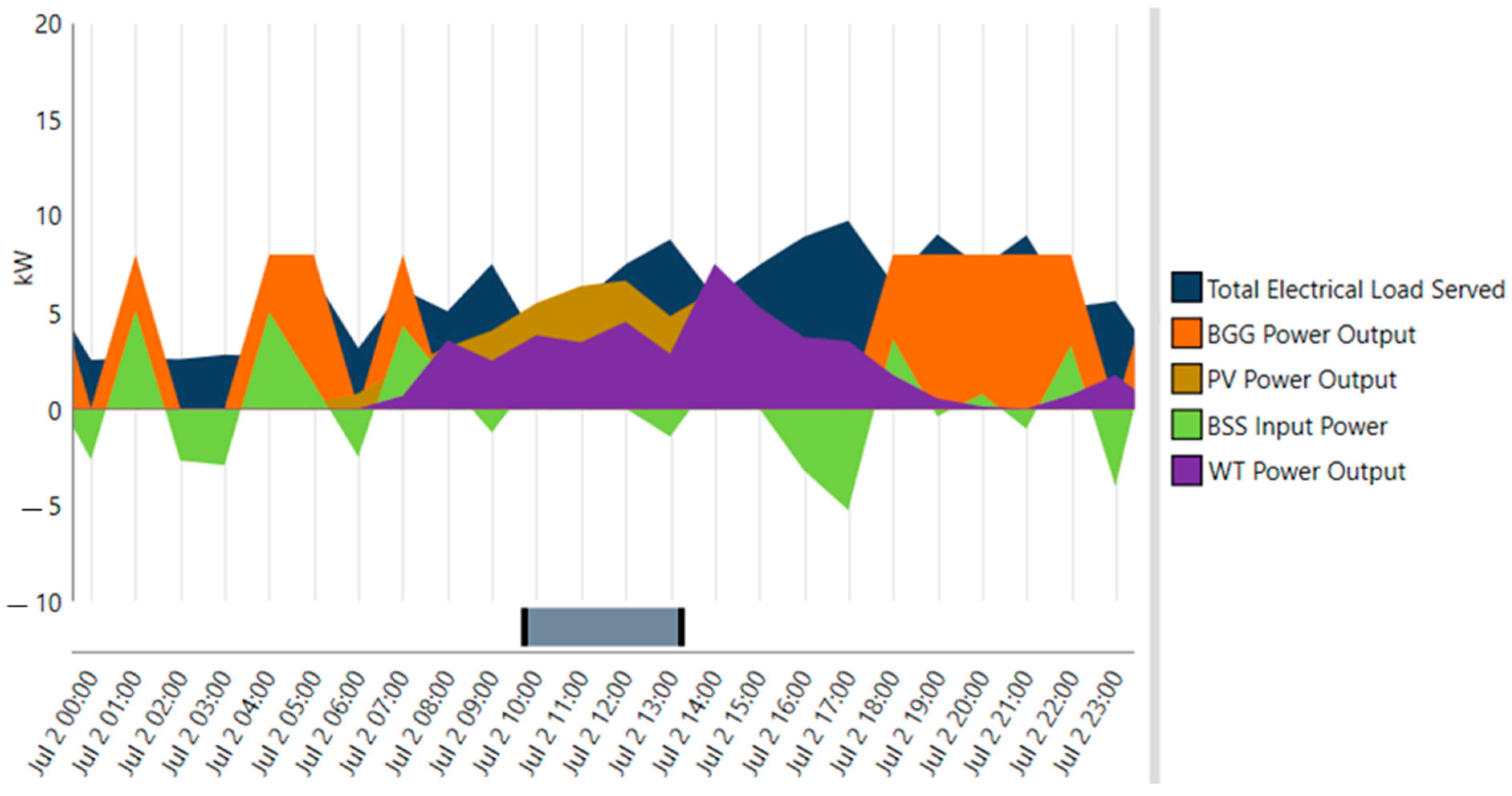

| HRES | Grid | Storage | Software | Performance Parameters |
|---|---|---|---|---|
| PV/WT [25] | On-grid | - | HOMER | NPC, LCOE |
| PV/WT/FC [26] | Off-grid | BSS/HT | HOMER | NPC, LCOE, Capacity, |
| PV/BGG [27] | On-grid | BSS | HOMER | NPC, LCOE |
| PV/FC [28] | On-grid | BSS | PSOAIW-PSOCF | NPC, LCOE |
| PV/WT/BGG [29] | Off-grid | BSS | HOMER | NPC, LCOE |
| PV/WT/FC [30] | Off-grid | BSS/HT | - | LCOE |
| PV/Hydrokinetic/FC [31] | Off-grid | BSS/HT | HOMER | NPC, LCOE, Capacity, Shortage |
| PV/FC [32] | Off-grid | HT/Super Capacitors | HOMER | NPC, LCOE |
| PV/WT [33] | On-grid Off-grid | BSS | HOMER | NPC, LCOE |
| BGG [34] | Off-grid | HT | HOMER | Hydrogen (H2) |
| PV/WT/BGG [35] | Off-grid | BSS | HOMER | LCOE |
| PV/ICE, PV/MGT [36] | Off-grid | BSS | MATLAB-Genetic Algorithm | LCOE, ηCHP |
| PV/CHP [37] | Off-grid | BSS | HOMER | Technic |
| WT/DG [38] | Off-grid | BSS | HOMER | LCOE, NPC, RF, CO2 |
| PV/WT [39] | Off-grid | BSS | MATLAB (Simulink) | LCOE, LPSP |
| PV [40] | On-grid | BSS | HOMER-MATLAB (Simulink) | Technic -LCOE |
| PV [41] | On-grid | BSS | HOMER-ML | NPC, LCOE |
| PV/DG [42] | On-grid | - | HOMER-ML | NPC, LCOE |
| PV [43] | Off-grid | BSS-HT | HOMER-MATLAB (Simulink) | NPC |
| Components | Installation Cost (USD/kW) | Renewal Cost (USD/kW) | O&M (USD/kW/yr) | Lifespan (yr) |
|---|---|---|---|---|
| PV system | 700 | 700 | 10 | 25 |
| WT | 290,000 | 25,000 | 20 | 20 |
| BGG | 2000 | 1250 | 0.01/h | 20,000 h |
| Battery | 300/battery | 300/battery | 10/battery | 10 |
| Converter | 300 | 300 | 0 | 15 |
| Name | Proposed Dispatch Strategy | LF Dispatch Strategy | CC Dispatch Strategy |
|---|---|---|---|
| WT (kW) | 10 | 10 | 10 |
| PV (kW) | 10 | 31 | 17.2 |
| BGG (kW) | 8 | 8 | 8 |
| BSS (kWh) | 12 | 54 | 33 |
| Converter (kW) | 12 | 13 | 11.2 |
| Dispatch Strategy | BGG | BSS | WT | PV | Conv. | System | |
|---|---|---|---|---|---|---|---|
| Initial Capital (USD) | PS | 16,000 | 6600 | 29,000 | 7000 | 3600 | 62,200 |
| LF | 16,000 | 29,700 | 29,000 | 21,683.76 | 3890.41 | 100,274.17 | |
| CC | 16,000 | 18,150 | 29,000 | 12,063.75 | 3371.96 | 78,585.72 | |
| Replacement (USD) | PS | 14,191.39 | 19,250.64 | 7970.18 | 0 | 1527.39 | 42,939.59 |
| LF | 8311.40 | 12,681.71 | 7970.18 | 0 | 1650.60 | 30,613.89 | |
| CC | 13,036.85 | 16,479.23 | 7970.18 | 0 | 1430.63 | 38,916.90 | |
| O&M (USD) | PS | 29,505.76 | 1551.30 | 129.28 | 1292.75 | 0 | 32,479.09 |
| LF | 19,174.09 | 6980.86 | 129.28 | 4004.53 | 0 | 30,288.76 | |
| CC | 26,279.06 | 4266.08 | 129.28 | 2227.92 | 0 | 32,902.33 | |
| Salvage (USD) | PS | 1039.08 | 1126.51 | 4491.71 | 0 | 287.47 | 6944.71 |
| LF | 1634.98 | 2282.58 | 4491.71 | 0 | 310.66 | 8719.94 | |
| CC | 1973.36 | 1778.34 | 4491.71 | 0 | 269.26 | 8512.67 | |
| Total (USD) | PS | 58,658.07 | 26,275.42 | 32,607.75 | 8292.75 | 4839.92 | 130,673.91 |
| LF | 41,850.51 | 47,079.98 | 32,607.75 | 25,688.29 | 5230.35 | 152,456.89 | |
| CC | 53,342.55 | 37,116.97 | 32,607.75 | 14,291.67 | 4533.34 | 141,892.28 |
| Solar irradiation (kWh/m2/day) | Wind Speed m/s | PV (kWh) | WT (kWh) | BGG (kWh) | Fuel Price (USD) | NPC (USD) | LCOE (USD/kWh) |
|---|---|---|---|---|---|---|---|
| 1.860 | 3.650 | 6565 | 18,116 | 30,560 | - | 149,201 | 0.239 |
| 1 | 332,618.70 | 0.533 | |||||
| 1.860 | 4.590 | 6565 | 32,109 | 23,048 | - | 130,267.80 | 0.207 |
| 1 | 268,599.30 | 0.428 | |||||
| 7.910 | 4.590 | 23,779 | 32,109 | 16,757 | - | 114,204.30 | 0.180 |
| 1 | 214,777.80 | 0.340 | |||||
| 7.910 | 3.650 | 23,779 | 18,116 | 21,758 | - | 127,281.60 | 0.203 |
| 1 | 257,873 | 0.411 |
Disclaimer/Publisher’s Note: The statements, opinions and data contained in all publications are solely those of the individual author(s) and contributor(s) and not of MDPI and/or the editor(s). MDPI and/or the editor(s) disclaim responsibility for any injury to people or property resulting from any ideas, methods, instructions or products referred to in the content. |
© 2024 by the authors. Licensee MDPI, Basel, Switzerland. This article is an open access article distributed under the terms and conditions of the Creative Commons Attribution (CC BY) license (https://creativecommons.org/licenses/by/4.0/).
Share and Cite
Köprü, M.A.; Öztürk, D.; Yıldırım, B. A Dispatch Strategy for the Analysis of the Technical, Economic, and Environmental Performance of a Hybrid Renewable Energy System. Sustainability 2024, 16, 7490. https://doi.org/10.3390/su16177490
Köprü MA, Öztürk D, Yıldırım B. A Dispatch Strategy for the Analysis of the Technical, Economic, and Environmental Performance of a Hybrid Renewable Energy System. Sustainability. 2024; 16(17):7490. https://doi.org/10.3390/su16177490
Chicago/Turabian StyleKöprü, Mehmet Ali, Dursun Öztürk, and Burak Yıldırım. 2024. "A Dispatch Strategy for the Analysis of the Technical, Economic, and Environmental Performance of a Hybrid Renewable Energy System" Sustainability 16, no. 17: 7490. https://doi.org/10.3390/su16177490





